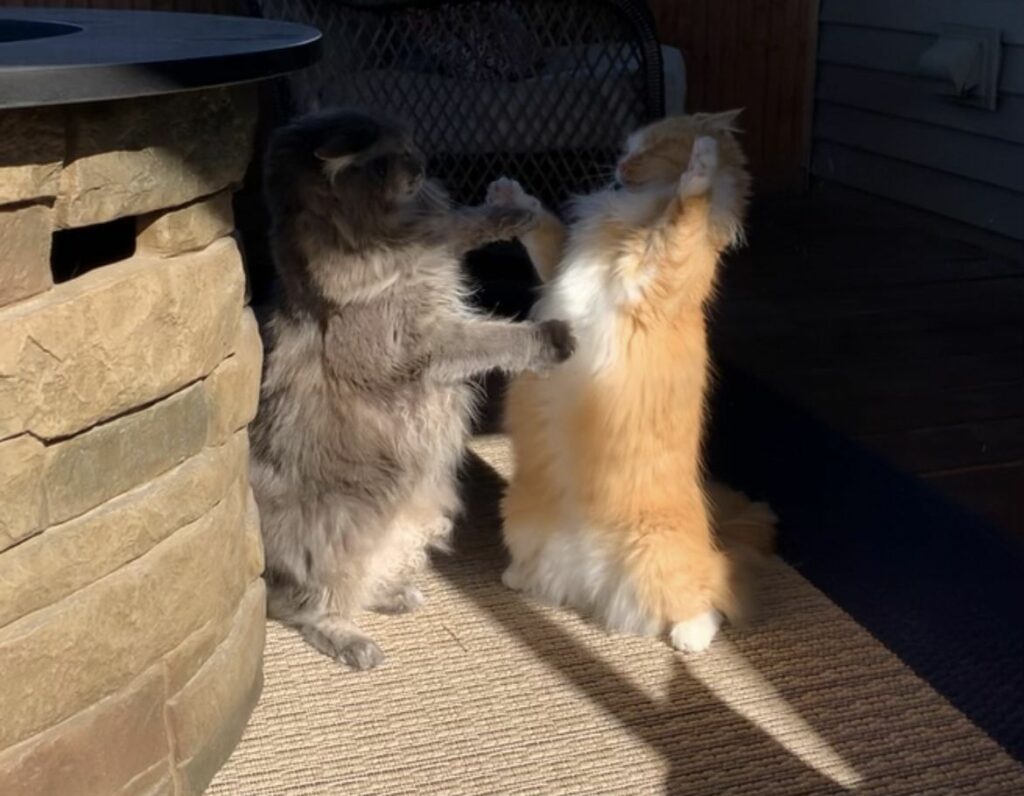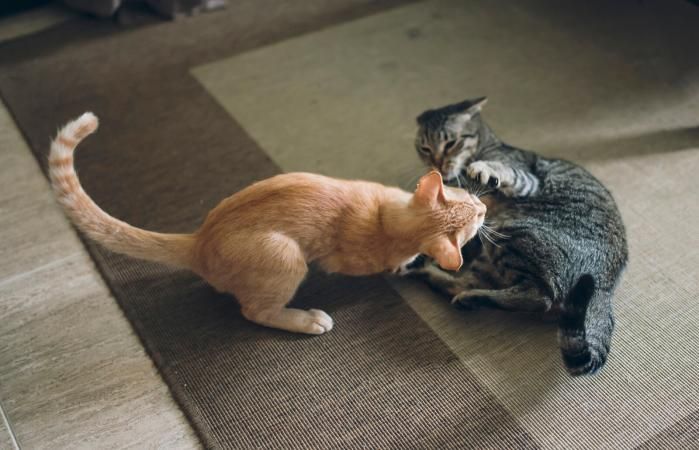As cat owners, we all want to provide a peaceful and harmonious environment for our feline friends. But sometimes, despite our best efforts, cats can engage in aggressive behavior towards each other, resulting in fights.
These fights can be distressing to witness and can lead to injuries for our beloved pets. But don’t lose hope! There are ways to prevent and stop catfighting, whether it’s between cats in the same household or with neighborhood cats.
You must know everything about preventing and stopping catfighting. So, whether you’re dealing with a new kitten who is still learning to get along with other cats or struggling with ongoing fights between cats in your household, this guide is here to help.
Here are 10 tips to help you keep the peace and ensure a calm and happy home for your cats:
1. Provide Enough Resources

You have to ensure each cat has enough resources in different locations. Provide each cat with one of everything (plus one extra) so that every cat feels they have a choice. Put these resources away from each other. This will give your cats plenty of opportunities to find them in any part of the home. You can prevent competition and fighting between your cats by providing sufficient resources.
When it comes to cat behavior, one of the most frustrating things to deal with is fighting between cats. Whether it’s between cats in the same household or with neighborhood cats, the sight of cats hurting each other can be heartbreaking. But, by ensuring that each cat has enough supplies in various hiding places, you can reduce the risk of competitiveness and violence between them.
To accomplish this, you will need to provide each cat with one of everything, plus one additional item, so that they have the impression that they have a choice. These resources are food, water, bedding, toys, boxes, scratching posts, and other things your cat needs to entertain and support itself. If they don’t have to share this stuff, your cats are less likely to fight each other.
2. Interrupt the Fighting

Distract the cats with a toy and avoid separating them by force. Use a toy to distract the cats and prevent you from having to separate them so you can stop the fighting physically.
If you see your cats fighting, your initial reaction may be to intervene and separate them. Still, you should proceed with extreme caution in this situation. Cats can become hostile when they are under a great deal of stress, and as a result of your efforts, you may get scratched quite a little.
Instead, it would be best if you made an effort to gently separate them from each other as long as you are not in immediate danger. You might also try to divert their attention with something they find enjoyable, like a toy that makes much noise. This may get their attention and put an end to the struggle.
3. Prevent Outdoor Fights

Keep cats indoors, especially at night, to prevent them from getting into fights outside. Try to find the other cat getting into trouble and get it under control. Keep your cats inside, especially at night, to prevent them from getting into fights outside.
Your cat wandering outside increases the chance of getting into a fight with another cat. You should be concerned about the possibility of these attacks being planned out in advance if your cat is usually calm and well-behaved. Keeping your cat inside would prevent these battles and ensure it is secure from harm. If you cannot keep your cat indoors, try to determine whether the other cat belongs to someone and whether or not it can be controlled.
If you can’t do either, you’ll need to support your cat when it stays outside. You should head out to assist if you hear your cat meowing in distress. Most odd cats will run away when they see a human. You might be able to stop the fight simply by being there and making your presence known.
4. Seek Professional Help
Address long-term aggression by seeking professional help, providing your cat opportunities for socialization, and training them to control their aggressive tendencies better. You may need a more long-term solution if your cat keeps picking fights with the other cats in your home or with other cats from the neighborhood. Seek the guidance of a qualified veterinarian or animal behaviorist to address these problems and provide long-term assistance to your cat.
Dealing with long-term aggression requires seeking professional help. It’s possible that a cat who gets into fights regularly is suffering from an extreme attack, or it could just have poor socialization skills. This is especially true if your cat keeps picking fights with the other cats in your home or with other cats from the neighborhood.
Seeking the guidance of a qualified veterinarian or animal behaviorist can help you address these problems and provide long-term assistance to your cat.
5. Encourage socialization
Promote healthy socialization in your cats by providing them opportunities to interact and play with one another. By providing them with opportunities to interact and play together, you can increase the cats’ socialization abilities and reduce the possibility that they will fight with one another.
To promote healthy socialization in your cats, make sure they have plenty of opportunities to socialize with one another and play together. Lack of interaction with other cats is one of the primary contributors to the problem of catfighting.
These cats do not comprehend how to engage with other cats or how to share resources. By providing them with opportunities to interact and play together, you can increase the cats’ socialization abilities and reduce the possibility that they will fight with one another.
6. Address Health Concerns
Address health concerns by consulting a veterinarian and following their advice. By taking them to the veterinarian and examining them, you will be able to address any underlying health issues that may cause the aggressive behavior.
Your cat’s health should be addressed by consulting a veterinarian and following their advice. Cats are notorious for their constant bickering due to their highly aggressive nature. This antagonism can indicate a disease that has not yet been detected.
The veterinarian will be able to diagnose your cat extensively and consult with you regarding essential steps to take to keep your cat healthy. It could be that maintaining your cat healthy could decrease your cat’s penchant for fighting.
7. Reduce Stress

Reduce stress by providing a calm environment for cats, making them feel safe during loud occasions, and offering them a peaceful retreat area. Keeping things clear and friendly in your place can help minimize stress and avoid arguments. In addition, make sure there is a quiet space for the cats to go to if a loud event occurs, such as a cozy bed or a secluded nook.
Cats may become agitated and aggressive when exposed to loud noises such as fireworks or other similar events. Keeping things calm and peaceful in the environment can help minimize stress and avoid arguments.
In addition, make sure there is a quiet space for the cats to go to if there is a loud event. Providing a calm environment and a peaceful retreat area will reduce stress in your cats and the likelihood of fights.
8. Provide a Peaceful Haven

Provide a peaceful haven for cats during the noise and encourage calm behavior through activities such as play or grooming. When they are relaxed and content, cats are less likely to engage in behavior that could be considered hostile.
When there is much noise, provide a quiet refuge for cats and encourage calm behavior by having them play or groom themselves. When they are relaxed and content, cats are less likely to engage in behavior that could be considered hostile.
You may help your cats remain calm and avoid fighting with one another by providing a quiet hideaway. You can also do this by encouraging them to relax via activities such as play, grooming, bathing, and massaging.
9. Understand Cat Behavior

Gain an understanding of cat behavior and the best way to react by observing and paying attention to how they act. Learn about your cats’ needs and how to respond to their behavior. This will assist you in creating an environment that is calm and will help you avoid confrontations.
Understanding cat behavior and the best way to react to it is essential. By understanding cat behavior and body language, you will be better able to anticipate when a disagreement may arise and take steps to avoid it.
You may discover that the reasons behind the catfights may be the annoyance of a smell, having to share their bed or cat litter or even fighting for your attention. By taking the time to understand your cat, you’ll be able to change the variables and eliminate the need for a fight.
10. Avoid Physical Force

When trying to diffuse a heated debate, steer clear of methods that use physical force and exercise caution. Always keep yourself safe and avoid placing yourself at risk. When seeking to resolve a dispute, refrain from taking a forceful stance. Taking this precaution will keep you safe and help you avoid worsening the condition.
When trying to diffuse a heated debate, you should, first and foremost, steer clear of methods that use physical force. Always keep yourself safe and avoid placing yourself at risk.
Remember that you are far superior in intelligence and physical strength than cats. Use subtle techniques to keep your cat under control. Cats are driven purely by instinct and desire for food, comfort, and safety. Leverage this to get them to calm down. Avoid showing physical force, as it may negatively impact them.
Final Thoughts
In conclusion, catfighting can be frustrating and heartbreaking for cat owners. However, by understanding the root causes of cat fights and implementing strategies to prevent and stop them, you can create a peaceful and harmonious environment for your feline friends.
One of the most important things to keep in mind is to provide each cat with sufficient resources and to place them in separate locations around the house. This can reduce competitiveness and the likelihood of fights.
When dealing with an active fight, it’s best to use a toy to distract the cats and prevent you from physically separating them. Keep your cats indoors, especially at night, to prevent them from getting into fights outside. Try to find the other cat getting into trouble and get it under control.
You can reduce the likelihood of catfights by providing a peaceful environment, promoting healthy socialization, and seeking professional help when needed. It’s your job to create a comfortable and healthy living space for your feline friends.
Further Reading





